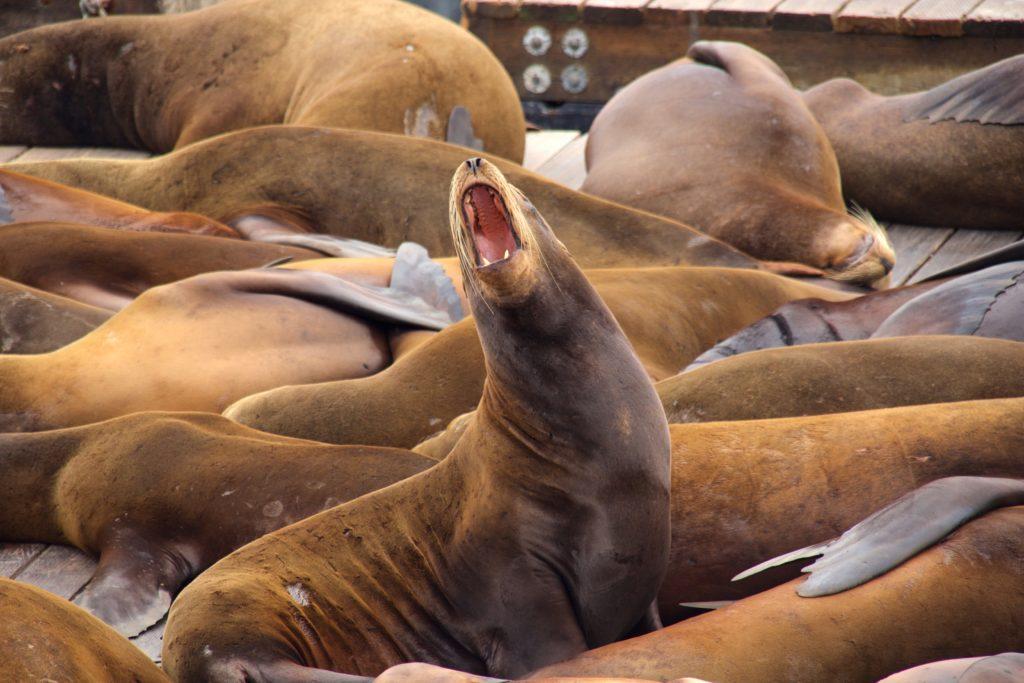California sea lions, like the ones Bay Area residents know to lazily sunbathe on Pier 39, are being killed by Oregon wildlife officials for dining on diminishing fish populations.
An estimated 93 sea lions per year will be euthanized by lethal injection as an emergency measure to protect endangered winter steelhead and spring chinook salmon, a move that is creating friction between marine mammal advocates and fish preservationists.
Rick Swart, spokesperson for the Oregon Department of Fish and Wildlife, said that although they are permitted to euthanize 93 animals annually, he has only seen 40 at a time come through the department. Swart said their euthanization program would not drastically reduce the number of sea lions at Pier 39, but would help stabilize salmon and steelhead populations that are vital to Oregon’s fish industry.
From the sea lion rookery, or breeding ground, in the California Channel Islands, male sea lions leave the females to care of their pups before they head north until the next breeding season. They take a route along the Columbia River into Oregon where they feast on the trove of fish along the Willamette River and the Bonneville Dam.
Michael Milstein, spokesperson for the National Oceanic and Atmospheric Administration in Oregon, said the situation at the dam was unique due to the fish ladder, a stair-like structure that allows the schools to bypass the dam. Here the flow of salmon and steelhead is congested, making the area particularly exciting for the hungry sea lions, who consume 25 percent of the native annual steelhead population, according to data from the Oregon Department of Fish and Wildlife.
“If your entire run is 2,000 fish and change and you whack 500 of them by the sea lions… you don’t have to be a math wizard to figure out if you’re going to run out of fish in a hurry,” Swart said.
According to Milstein, salmon also have a particular importance to the ecosystem–especially after they breed. When salmon spawn, their life’s work is done and then they die. “The nutrients from their bodies essentially helps fertilize the ecosystem and helps support the growth of plants and wetlands,” said Milstein.
The capturing of sea lions for euthanasia began in December 2018 when Congress passed the Endangered Salmon Predation Prevention Act, allowing NOAA to issue permits authorizing the culling of sea lions.
In determining which sea lions get to live and which don’t, Swart says the animals “self-select”. In other words, they willingly go into open trap doors set by the Oregon Department of Fish and Wildlife and if the sea lions sit in the trap long enough, the appropriate team member is notified, at which the sea lion is sent to slaughter.
The other legal green light for euthanasia: If a sea lion is seen near Willamette Falls eating at least two fish.
Sea lions can easily consume double that amount each day. “They don’t even eat them all … they just rip them up sometimes,” Swart said. “It makes me sort of sick to my stomach to see those fish get thrashed.”
Dr. Jeff Boehm, executive director of the Marine Mammal Center in Sausalito, said his organization understands the economic and social complexities of the steelhead shortage, but called the sea lion killings short-sighted.
“First and foremost our interest is the marine mammals that we care for and their ocean home,” Boehm said. “And we just simply think there are other solutions, other issues that should be addressed before killing sea lions as the short-term solution.”
Sea lions were endangered until the 1970s. The Marine Mammal Protection Act went into effect in 1972, which commenced the Bay Area marine mammal advocates’ decades-long battle to keep the population from going extinct.
California sea lion numbers climbed from 88,924 to around 300,000 since the act passed.
This is why preservationists like Boehm are calling the cullings an “assault” on the very act responsible for elevating the sea lion population back to healthy numbers.
“California sea lions themselves, especially here in San Francisco Bay Area, are just iconic for the region,” Boehm said. “They are welcomed in the San Francisco Bay, celebrated at Pier 39 and are just a part of our natural history culture on this coast.”
Milstein said, “The challenge here is to find the balance between [sea lions and fish] that allows both species to recover and be healthy.”
Both sides agreed that creating better fish habitats as opposed to killing sea lions is ideal in a long-term preservation plan. Swart suggested alternatives such as helping facilitate fish migrations and supporting hatcheries.
“The erosion of the ecosystem is something that none of us wants to happen and every incremental loss in the ecosystem hurts the system as a whole,” he said.








Leigh • Feb 13, 2019 at 3:39 pm
If you want to protect fish, stop eating them and stop damming and polluting their habitat. The solution is not to murder other animals who’ve long lived in predator/prey harmony with these fish until humans screwed it all up.